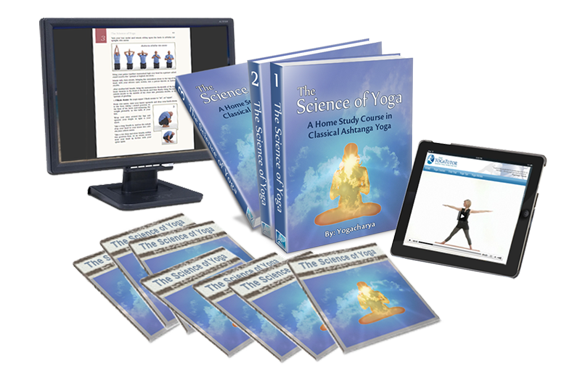[ Excerpt from The Science of Yoga, page 154 ]
Tantra Yoga
Tantra is the ancient Indian science of energy activation and control, based on the Shiva-Shakti principle of polar energies, similar to the concepts of solar and lunar energies in hatha yoga. Its aim is to remove the separation of these energies within the human being so that the cosmic union may become a direct experience.
The term tantra, however, is often misunderstood and carries with it several misleading connotations today, many of which revolve purely around sex.
There are two major divisions or paths in tantra: the vama marga (left hand path), and the dakshina marga (right hand path). Vama marga tantra deals with principles of energy in a materialistic, exoteric and literal manner, whereas the dakshina marga tantra deals with them in a subtler, esoteric and more refined manner.
Vama marga is a rajasic and potentially dangerous form of this school of yoga, while dakshina marga can be seen as a sattvic (higher) and evolutionary path.
The dakshina margis of the evolutionary school interpret the directives of the Tantras and Agamas, the classical tantric texts, in a metaphorical sense, cultivating a body of practices to awaken the kundalini energy. They use internal rituals and symbolic concentrations and meditations, which lead to a harmonizing of all the energies of the being and lead to transcendence to higher states of awareness.
The vama margis practice entirely different rituals, as they understand the teachings in a literal manner. Hence, the vama margis often break social taboos, which may be justified by understanding that their goal is not sensual gratification, but self-transcendence in the context of bodily existence. But this is a dangerous path for the uninitiated, and too often misunderstood and grossly misused.
Tantra has its own fully developed secret language (sandha bhashya) and unless the student fully understands this language, he may lose himself in the body rather than transcend it. For this very reason, the practice of tantra should never be approached except under the guidance of a qualified and realized guru.
Mantra Yoga
A mantra is a sound, syllable, word, or a group of words that are repeated verbally or mentally. They are very specific articulate sounds whose proper utterance leads to an awakening of the consciousness through the unification of the subconscious, the conscious mind and the cosmic consciousness.
This yoga, which has its origins in the VEDAS, is that of setting the microcosmic being, the worldly self, into resonance, through the agency of various imitative sounds, called vacaka, with the various subtle energies of the macrocosmic universe.
This invocation (mantra) is a special name or symbol which embodies in a mysterious manner the power and quality of the vacya, or that thing which it indicates. So then, it is possible through mantra to develop a connection or relationship (resonance) with that thing, be it a higher power, or certain psychic force. The most profound of the mantras is the Pranava AUM.
Yantra Yoga
The Sanskrit root word yan means "change." Tra refers to a "tool," so the word yantra can be literally translated to mean a "tool of (for) change."
Yantra is the arcane science of number, name and form. It is a subset of jyotish (vedic astrology), which interprets the inherent mathematical/numeric structures that are the fundamental organization of the Universe (known also as sacred geometry), those forms, structures and relationships which also lie deep within the collective unconscious of man.
The term yantra is most commonly used in connection with complex geometrical forms called rupa, which serve as meditation devices, or mandala dharana. These geometric structures impart a hidden or concealed meaning and serve as keys to unlock latent human powers and energies. When one has the key to the meaning encoded within the geometric/mathematical structure of a yantra, powerful knowledge is gained.
Yantra then, is a spiritual exploration through mathematics, a sophisticated meditation upon numbers which systematically analyses the manifest world of number, name and form, and explores their relationships.
Yantra provides a method by which to know one’s self better, to understand one's purpose in life, and to learn to live in tune with the ever-changing cycles of nature, rather than out of tune with them.
[Continued...]
---------------------
NOTE: This yoga article is an excerpt from The Science of Yoga, an online yoga training program with streaming yoga videos and 600 pages of step-by-step yoga instruction.

"The Science of Yoga is a course worthy of
leather binding and an honored place in the
finest libraries in the world
... It is indeed a masterful work."
Dr. John Michael Christian
AwakeningWithYoga.com
Learn More About
The Science of Yoga Course
|






